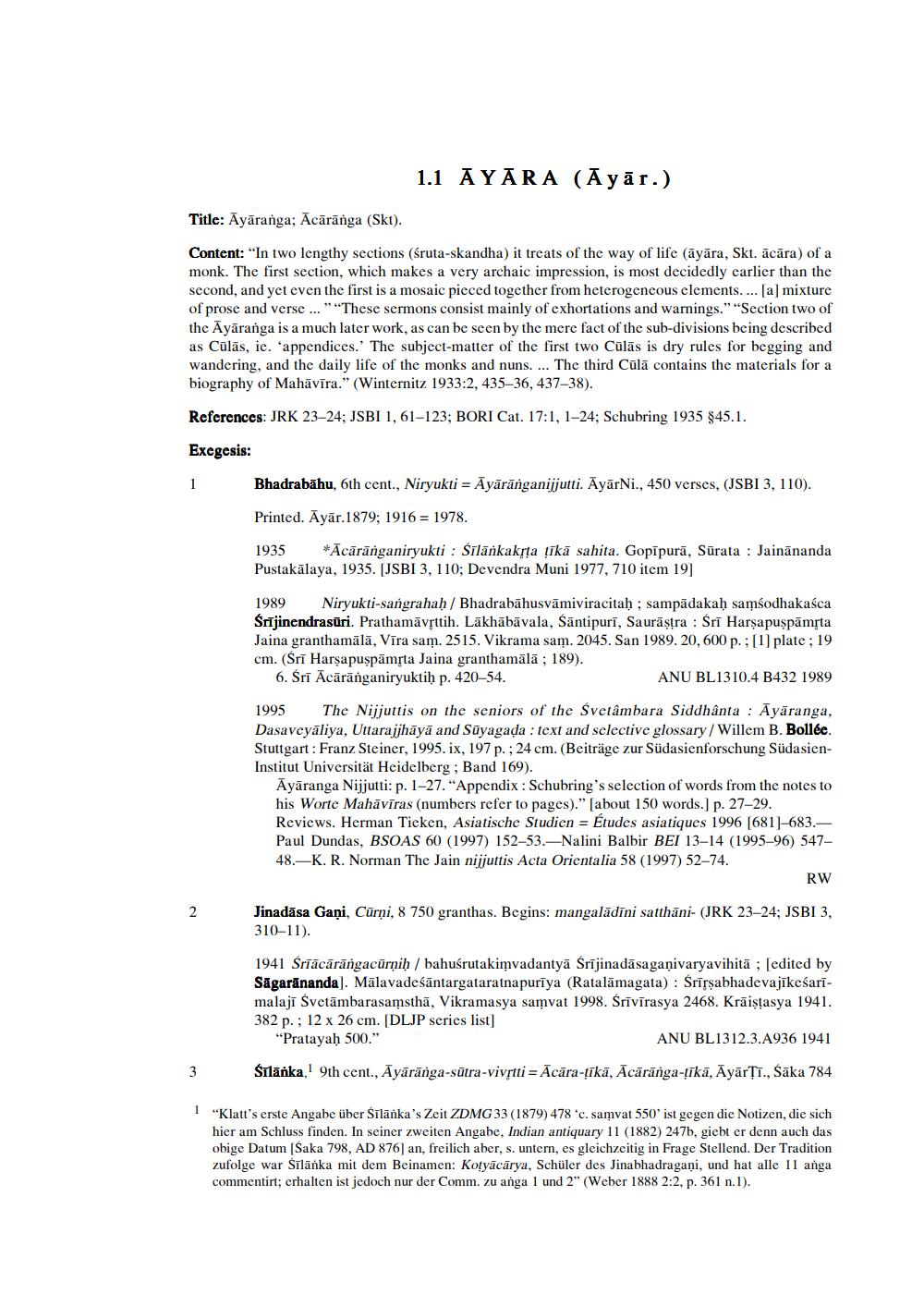________________
1.1 AYARA (Ayār.)
Title: Āyāranga; Ācārānga (Skt).
Content: "In two lengthy sections (śruta-skandha) it treats of the way of life (āyāra, Skt. ācāra) of a monk. The first section, which makes a very archaic impression, is most decidedly earlier than the second, and yet even the first is a mosaic pieced together from heterogeneous elements. ... (a) mixture of prose and verse ..." "These sermons consist mainly of exhortations and warnings." "Section two of the Ayāranga is a much later work, as can be seen by the mere fact of the sub-divisions being described as Cūlās, ie. 'appendices. The subject-matter of the first two Cūlās is dry rules for begging and wandering, and the daily life of the monks and nuns. ... The third Cūlā contains the materials for a biography of Mahāvīra." (Winternitz 1933:2, 435–36, 437-38).
References: JRK 23-24; JSBI 1, 61-123; BORI Cat. 17:1, 1-24; Schubring 1935 $45.1.
Exegesis:
Bhadrabāhu, 6th cent., Niryukti = Āyārānganijjutti. AyārNi., 450 verses, (JSBI 3, 110). Printed. Ayār.1879; 1916 = 1978.
1935 Ācārānganiryukti : Silankakrta tīkā sahita. Gopīpurā, Sūrata : Jainānanda Pustakālaya, 1935. [JSBI 3, 110; Devendra Muni 1977, 710 item 19)
1989 Niryukti-sangrahah / Bhadrabāhusvāmiviracitah; sampādakaḥ samsodhakasca Śrījinendrasūri. Prathamāvrttih. Lākhābāvala, śāntipuri, Saurāṣtra : Sri Harsapuspāmsta Jaina granthamālā, Vīra sam. 2515. Vikrama sam. 2045. San 1989. 20, 600 p.:[1] plate ; 19 cm. (Śrī Harsapuspāmrta Jaina granthamālā ; 189). 6. Sri Acārānganiryuktih p. 420-54.
ANU BL1310.4 B432 1989
1995 The Nijjuttis on the seniors of the Svetâmbara Siddhanta : Āyäranga, Dasaveyāliya, Uttarajjhāyā and Sūyagada : text and selective glossary/Willem B. Bollée. Stuttgart : Franz Steiner, 1995. ix, 197 p. ; 24 cm. (Beiträge zur Südasienforschung SüdasienInstitut Universität Heidelberg, Band 169).
Ayäranga Nijjutti: p. 1-27. "Appendix : Schubring's selection of words from the notes to his Worte Mahāvīras (numbers refer to pages)." (about 150 words.] p. 27-29. Reviews. Herman Tieken, Asiatische Studien = Études asiatiques 1996 (681)-683.Paul Dundas, BSOAS 60 (1997) 152-53.-Nalini Balbir BEI 13-14 (1995-96) 547– 48.-K. R. Norman The Jain nijjuttis Acta Orientalia 58 (1997) 52-74.
RW
Jinadāsa Gaņi, Cūrņi, 8 750 granthas. Begins: mangalādīni satthāni- (JRK 23–24; JSBI 3, 310–11).
1941 Sriācārāngacūrņih / bahuśrutakimvadanty. Śrījinadāsaganivaryavihitā ; [edited by Sāgarānanda). Mālavadeśāntargataratnapuriya (Ratalāmagata) : Srīşşabhadevajīkeśarimalaji Svetāmbarasamsthā, Vikramasya samvat 1998. Srīvīrasya 2468. Krāistasya 1941. 382 p. ; 12 x 26 cm. [DLJP series list **Pratayah 500."
ANU BL1312.3.A936 1941
Śīlānka, 9th cent., Ayāränga-sütra-vivrtti = Ācāra-tikā, Ācāränga-tīkā. ĀyärTi., Saka 784
1 "Klatt's erste Angabe über Sīlānka's Zeit ZDMG 33(1879) 478 c. samvat 550' ist gegen die Notizen, die sich
hier am Schluss finden. In seiner zweiten Angabe, Indian antiquary 11 (1882) 247b, giebt er denn auch das obige Datum (Saka 798, AD 876] an, freilich aber, s. untern, es gleichzeitig in Frage Stellend. Der Tradition zufolge war Šīlānka mit dem Beinamen: Kotyācārya, Schüler des Jinabhadragani, und hat alle 11 anga commentirt; erhalten ist jedoch nur der Comm. zu anga 1 und 2" (Weber 1888 2:2, p. 361 n.1).




